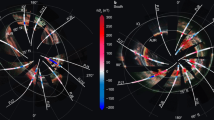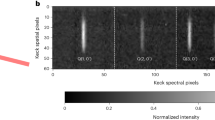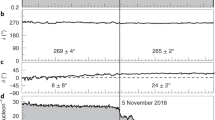Abstract
Io leaves a magnetic footprint on Jupiter's upper atmosphere that appears as a spot of ultraviolet emission that remains fixed underneath Io as Jupiter rotates1,2,3. The specific physical mechanisms responsible for generating those emissions are not well understood, but in general the spot seems to arise because of an electromagnetic interaction between Jupiter's magnetic field and the plasma surrounding Io, driving currents of around 1 million amperes down through Jupiter's ionosphere4,5,6. The other galilean satellites may also leave footprints, and the presence or absence of such footprints should illuminate the underlying physical mechanism by revealing the strengths of the currents linking the satellites to Jupiter. Here we report persistent, faint, far-ultraviolet emission from the jovian footprints of Ganymede and Europa. We also show that Io's magnetic footprint extends well beyond the immediate vicinity of Io's flux-tube interaction with Jupiter, and much farther than predicted theoretically4,5,6; the emission persists for several hours downstream. We infer from these data that Ganymede and Europa have persistent interactions with Jupiter's magnetic field despite their thin atmospheres.
This is a preview of subscription content, access via your institution
Access options
Subscribe to this journal
Receive 51 print issues and online access
$199.00 per year
only $3.90 per issue
Buy this article
- Purchase on Springer Link
- Instant access to full article PDF
Prices may be subject to local taxes which are calculated during checkout



Similar content being viewed by others
References
Connerney, J. E. P. et al. Images of excited H+3 at the foot of the Io flux tube in Jupiter's atmosphere. Science 262, 1035–1038 (1993).
Clarke, J. T. et al. Far-ultraviolet imaging of Jupiter's aurora and the Io “footprint”. Science 274, 404–409 (1996).
Prangé, R. et al. Rapid energy dissipation and variability of the Io–Jupiter electrodynamic circuit. Nature 379, 323–325 (1996).
Goldreich, P. & Lynden-Bell, D. Io, a Jovian unipolar inductor. Astrophys. J. 156, 59–78 (1969).
Belcher, J. W. The Jupiter–Io connection, an Alfven engine in space. Science 238, 170–176 (1987).
Neubauer, F. M. Nonlinear standing Alfven wave current system at Io: theory. J. Geophys. Res. 85, 1171–1178 (1980).
Clarke, J. T. et al. Hubble Space Telescope imaging of Jupiter's UV aurora during the Galileo orbiter mission. J. Geophys. Res. 103(E9), 20217–20236 (1998).
Prangé, R. et al. Detailed study of FUV Jovian auroral features with the post COSTAR Hubble Faint Object Camera. J. Geophys. Res. 103, 20195–20210 (1998).
Dols, V., Gérard, J. C., Clarke, J. T., Gustin, J. & Grodent, D. Diagnostics of the Jovian aurora deduced from ultraviolet spectroscopy: model and GHRS observations. Icarus 147, 251–266 (2000).
Ballester, G. E. et al. Time-resolved observations of Jupiter's far-UV aurora: comparison of WFPC 2 and IUE. Science 274, 409–413 (1996).
Hill, T. W. The Jovian auroral oval. J. Geophys. Res. 106(A5), 8101–8108 (2001).
Bunce, E. & Cowley, S. W. H. Divergence of the equatorial current in the dawn sector of Jupiter's magnetosphere: analysis of Pioneer and Voyager magnetic field data. Planet. Space Sci. 49, 1089–1113 (2001).
Cowley, S. W. H. & Bunce, E. Origin of the main auroral oval in Jupiter's coupled magnetosphere-ionosphere system. Planet. Space Sci. 49, 1067–1088 (2001).
Connerney, J. E. P., Acuna, M. H., Ness, N. F. & Satoh, T. New models of Jupiter's magnetic field constrained by the Io flux tube footprint. J. Geophys. Res. 103(E9), 11929–11939 (1998).
Connerney, J., Satoh, T. & Baron, R. H+3 emission at the foot of the Io flux tube. Bull. Am. Astron. Soc. 27, 1147 (1996).
Russell, C. & Huddleston, D. The unipolar inductor myth: mass addition or motional electric field as the source of field-aligned currents at Io. Adv. Space Res. 26, 1665–1670 (2000).
Frank, L. A. et al. Plasma observations at Io with the Galileo spacecraft. Science 274, 394–395 (1996).
Crary, F. & Bagenal, F. Coupling the plasma interaction at Io to Jupiter. Geophys. Res. Lett. 24, 2135–2138 (1997).
Bethe, H. & Salpeter, E. Quantum Mechanics of One and Two Electron Systems 285 (Plenun, New York, 1977).
Crary, F. J. On the generation of an electron beam by Io. J. Geophys. Res. 102, 37–49 (1997).
Wilkinson, M. H. Evidence for periodic modulation of Jupiter's decametric radio emission. J. Geophys. Res. 103(9), 19985–19991 (1998).
Kurth, W., Gurnett, D. A. & Menietti, J. D. in Radio Astronomy at Long Wavelengths 213–217 (AGU Monograph 119, American Geophysical Union, Washington DC, 2000).
Kivelson, M. G. et al. Discovery of Ganymede's magnetic field by the Galileo spacecraft. Nature 384, 537–541 (1996).
Hall, D. T., Feldman, P., McGrath, M. A. & Strobel, D. F. The far-ultraviolet oxygen airglow of Europa and Ganymede. Astrophys. J. 499, 475–481 (1998).
Feldman, P. D. et al. UV imaging of polar aurora on Ganymede. Astrophys. J. 535, 1085–1090 (2000).
Acknowledgements
This work is based on observations with the NASA/ESA Hubble Space Telescope, obtained at the Space Telescope Science Institute, which is operated by AURA for NASA. The research was supported by grants from the Space Telescope Science Institute and from NASA to the University of Michigan. J.T.C. acknowledges the hospitality of the Institut d'Astrophysique du CNRS in Paris during the preparation of this paper, and J.C.G. and D.G. acknowledge support from the Belgian Fund for Scientific Research and the PRODEX program of ESA. L.B.J. acknowledges support from the Institut National des Sciences de l'Univers and the PNP programme.
Author information
Authors and Affiliations
Corresponding author
Ethics declarations
Competing interests
The authors declare no competing financial interests.
Rights and permissions
About this article
Cite this article
Clarke, J., Ajello, J., Ballester, G. et al. Ultraviolet emissions from the magnetic footprints of Io, Ganymede and Europa on Jupiter. Nature 415, 997–1000 (2002). https://doi.org/10.1038/415997a
Received:
Accepted:
Issue Date:
DOI: https://doi.org/10.1038/415997a
This article is cited by
-
10th China Trajectory Optimization Competition: Problem description and summary of the results
Astrodynamics (2021)
-
Science Goals and Mission Objectives for the Future Exploration of Ice Giants Systems: A Horizon 2061 Perspective
Space Science Reviews (2021)
-
The Juno Magnetic Field Investigation
Space Science Reviews (2017)
-
The Juno Waves Investigation
Space Science Reviews (2017)
Comments
By submitting a comment you agree to abide by our Terms and Community Guidelines. If you find something abusive or that does not comply with our terms or guidelines please flag it as inappropriate.



